市场资讯及洞察

New U.S. Sanctions on Russia as Putin Conducts Nuclear Tests
The U.S. has imposed new sanctions on Russia's two largest oil companies, Rosneft and Lukoil, after planned peace talks between Trump and Putin collapsed on Wednesday.
Oil prices spiked 3% after the announcement, with Brent crude hitting $64 per barrel.
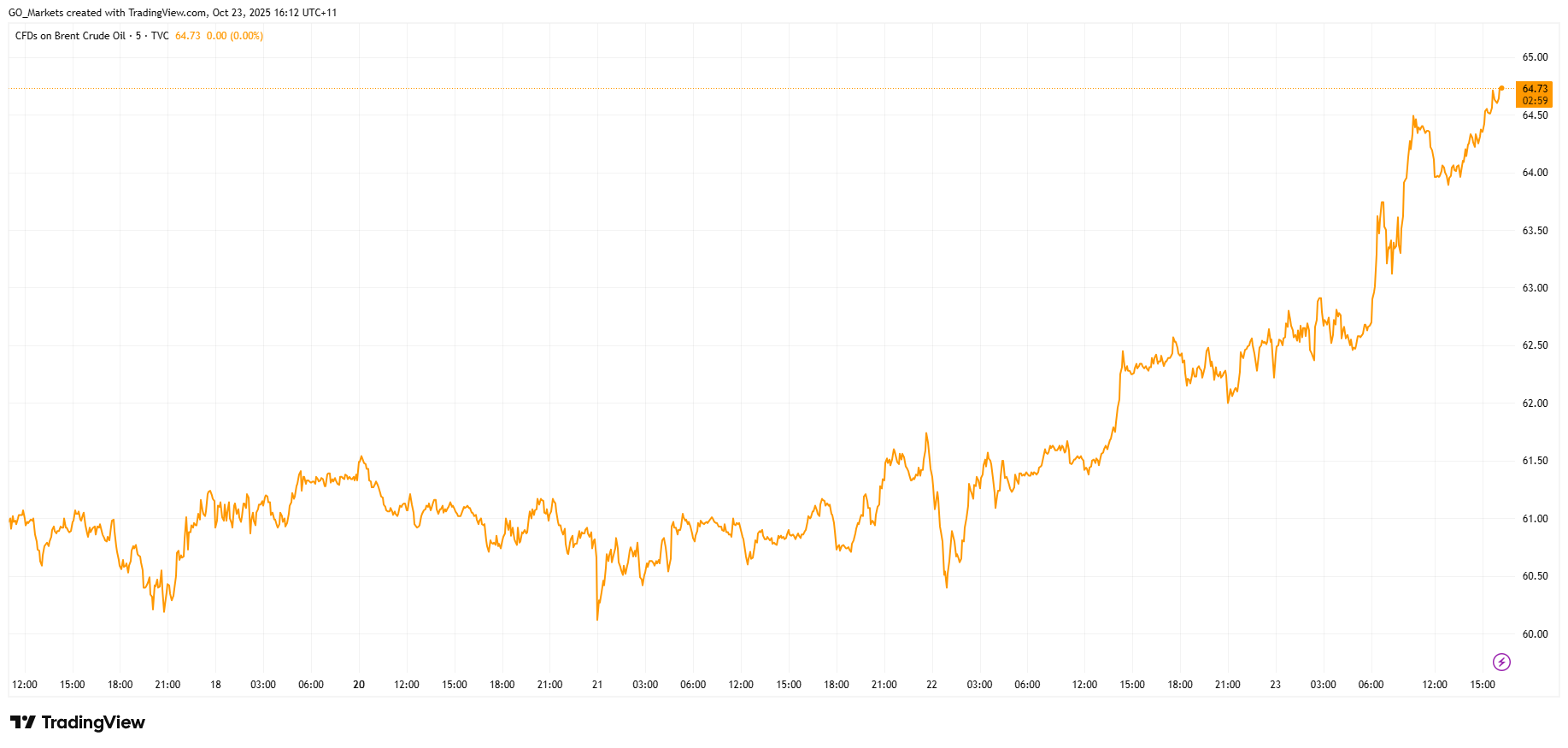
The targeted companies are among the world's largest energy exporters, collectively shipping about three million barrels of oil daily and accounting for nearly half of Russian production.
The sanctions build on recent European measures, as the UK targeted the same companies last week and the EU approved its own sanctions package on Wednesday.
In a show of force coinciding with the new sanctions, Putin supervised strategic nuclear exercises on Wednesday involving intercontinental ballistic missile launches from land and submarine platforms.
While the Kremlin emphasised these were routine drills, the highly coincidental timing is notable.
For markets, the key question now is whether secondary sanctions will follow, and if Trump’s enforcement remains strict. Traders will watch closely for any TACO signals that see Trump ease pressure in an attempt to restart negotiations.
Historic PM Wasting No Time on Celebrations
Sanae Takaichi made history this week as Japan's first female Prime Minister. The 64-year-old conservative leader, dubbed the "Iron Lady,” is already rolling out an aggressive policy agenda that could reshape Japan's economic and geopolitical position.
Her first major move is an economic stimulus package expected to exceed US $92 billion. The package includes abolishing the provisional gasoline tax and raising the tax-free income threshold from ¥1.03 million ($6,800), moves designed to put more money in consumers' pockets and battle inflation.

Her next move will come when Trump arrives in Tokyo next week, as the Japanese government is finalising a purchase package including Ford F-150 pickup trucks, US soybeans, and liquefied natural gas as sweeteners for trade talks.
Takaichi has campaigned on being a champion for expansionary fiscal policy, monetary easing, and heavy government investment in strategic sectors, including AI, semiconductors, biotechnology, and defence.
Critical Workers to Miss First Paycheck Due to Shutdown
The U.S. government shutdown is on the verge of creating a crisis for aviation safety, with 60,000 workers set to miss their first full paycheck this week.
These essential workers, who earn an average of $40,000 annually, already saw shortened paychecks last week. By Thursday, many will receive pay stubs showing zero compensation for the coming period, forcing impossible choices between basic necessities and reporting to work.
During the last extended shutdown, TSA sick-call rates tripled by Day 31, causing major delays at checkpoints and reduced air traffic in major hubs like New York — disruptions which are directly attributed to pressuring the end of the previous shutdown.
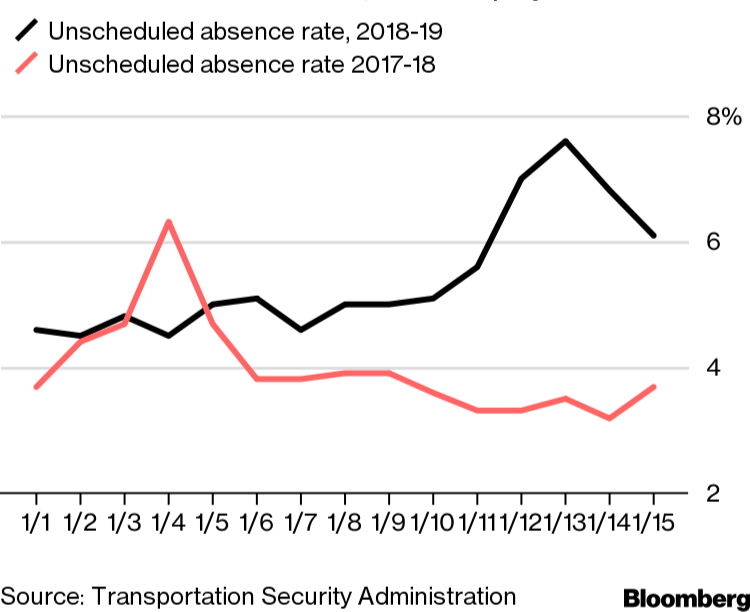
The National Air Traffic Controllers Association warns that similar pressures are building, with many workers soon to be facing a decision between attending their shift or putting food on the table.
.jpg)

10月21日收盘,贵金属市场出现明显回调。伦敦现货黄金盘中最低跌至4002美元/盎司,沪金(au7777)下跌4.75%,报943.3元/克,创下2013年以来最大单日跌幅。全球黄金股和金矿股同步下挫,美股的GLD、GDX下跌约5%,国内的山东黄金、中金黄金、赤峰黄金等个股跌幅均接近或超过4%。
此前两个月,黄金价格持续上行,主要受美国政府关门风险、贸易摩擦升温以及各国央行增持黄金等因素推动。然而,10月21日欧洲多国领导人发表联合声明,支持通过谈判推动俄乌停火,市场由此预期地缘政治风险可能缓和,避险需求下降,金价随即转为下行。
同时,前期涨幅过快积累了较多获利盘。黄金价格一度接近4400美元/盎司,短期内出现明显超买迹象,于10月中旬成为全球最高市值的资产大类。

部分投资者选择在高位获利了结。美元指数的短期反弹也对黄金形成一定压力,资金流向出现调整。
白银市场的波动更加明显。白银期货单日下跌超过7%,为十余年来最大跌幅。本轮白银上涨行情始于10月初,期间价格突破50美元关口,现货市场短缺、租赁利率飙升等因素推动价格快速上升。随着逼空行情结束,投机性资金回撤,银价在短时间内大幅回落,几乎回吐了此前两周的涨幅。
除地缘政治变化外,技术性和结构性因素也在加速调整。美国政府临时关门导致持仓数据缺失,市场对投机性多头头寸规模缺乏清晰判断,放大了价格波动。印度节日季买需阶段性结束,亚洲实物黄金买盘减少,也在一定程度上削弱了现货支撑。
从市场结构来看,此次调整具有阶段性特征。过去几周,黄金、白银、美股以及美元指数同步上涨的格局本身较为罕见,显示资金短期内对不同资产类别的配置逻辑出现错位。随着避险情绪减弱和美元走强,贵金属市场的价格修正属于正常的回归过程。
白银走势的变化具有代表性。10月9日突破50美元后,市场情绪高涨,资金迅速集中于贵金属板块,印度主要节日集中在10-11月,也对于白银买盘形成强烈支撑。但从10月13日开始,随着供需关系趋于平衡、逼空行情缓解和印度节日季的传统买盘在月中逐渐告一段落,白银上涨动能减弱。本轮回调主要体现为市场在高波动阶段的自然降温。

国际投行对后续走势看法不一。花旗银行维持金价4000美元的中期目标,认为在回调后实物买盘可能重新介入,从而限制下行空间。瑞银则认为短期市场仍由期货抛售主导,现货需求疲弱使金价在短期内可能继续承压。
总体来看,当前贵金属市场的波动更多反映资金面和情绪面的调整,而非基本面的根本性转变。短期内,金价预计在高位震荡,中期走势仍取决于美国经济数据、通胀预期以及美联储的货币政策方向,请大家重点关注即将到来的周五美国CPI、下周美联储FOMC会议和11月份中美贸易谈判进展,都会对黄金价格造成一定影响。
从历史经验看,黄金在快速上涨后出现短期调整并不罕见。价格修正往往有助于市场重新建立平衡。未来若全球经济不确定性仍然较高,或通胀压力再度上升,黄金仍具备重新获得支撑的可能。

对于投资者而言,当前阶段的重点在于关注宏观数据变化和政策信号,而非追逐短线波动。黄金作为资产配置的一部分,其中长期价值仍需结合全球经济走势与货币环境综合判断。
.jpg)

本周全球市场情绪偏谨慎,投资者关注即将发布的重要经济数据和企业财报,同时也在重新评估对美联储降息的预期。
美国市场
美国股市方面,周一表现出强劲反弹势头,三大指数齐涨。标普500指数上涨约1.1%,道琼斯工业平均指数与纳斯达克综合指数分别上涨1.1%与1.4%,凸显科技股与大型蓝筹股的带动作用。科技板块中,苹果因 iPhone 销售表现强劲上涨近4%,而英伟达则凭借其新一代芯片发布受到关注,提振整体科技板块人气。
与此同时,10 年期美债收益率上升至 4.68%,为近两周新高,显示投资者在经济数据与通胀预期交织下重新评估美联储的政策路径。收益率走高提振美元表现,并强化其避险吸引力,推动美元指数重回106上方。受此影响,商品货币普遍承压,澳元与纽元兑美元均小幅下挫。
投资者对于即将发布的财报季保持关注。与此同时,美国与中国贸易关系出现缓和迹象,带动市场情绪回暖,但部分投资者担忧政策不确定性仍存,或在短期内引发波动。总体而言,美股反弹体现出资金对科技板块的信心,但在高利率与强美元环境下,市场仍处于谨慎乐观的阶段。
澳大利亚市场
澳大利亚股市 ASX200 指数下跌 0.8%,铁矿石价格回落至 106 美元 / 吨,必和必拓(BHP)和力拓(RIO)等矿业股对大盘构成拖累。澳大利亚统计局(ABS)数据显示,9 月份失业率升至 4.5%,为 2021 年 11 月以来最高水平,表明劳动力市场有所放缓。这一数据使得市场对澳大利亚储备银行(RBA)未来降息的预期升温。澳元兑美元汇率一度短暂反弹,但随后受到美元强势的限制,目前在 0.652 附近交易。
数字货币市场
数字货币市场延续震荡走势。本月 10 日,由于地缘政治与中美贸易紧张情绪回升,数字货币市场出现剧烈波动。全球最大数字货币比特币日内跌幅超过10%,全球总市值缩水约 190 亿美元(约合人民币 2400 亿元),比特币短线跌破10.6万美元关口,以太坊亦失守3800美元一线。
随后,随着投资者逢低买入及部分机构资金回流,市值有所回升,重新回涨至11万美元。市场普遍认为,在宏观经济不确定性与监管风险并存的背景下,数字资产短期内仍难以摆脱高波动特征。投资者可关注美国 SEC 对数字货币 ETF 审批进展,以及美债收益率变化对市场资金流向的影响。整体而言,市场情绪依然偏谨慎,投资者应保持理性并密切关注宏观经济与政策变化。
大宗商品市场
大宗商品方面,避险需求推动贵金属价格走高。近期黄金价格成为市场关注焦点,一度突破两个月新高,达到每盎司 4381 美元,避险买盘明显增加。这反映出市场对地缘政治风险与全球经济放缓的担忧加深。现货黄金价格突破4100美元/千克关口后虽略有回落,但仍处于强势区间,资金持续流入黄金ETF产品,显示避险情绪仍然高涨。
白银走势同步跟随黄金上涨,受工业与避险双重属性支撑,涨幅略优于黄金。原油价格较月初高点明显回落,主要受库存回升和需求疲软影响。短期内油价或维持区间震荡格局。若美国后续公布的通胀与就业数据继续走弱,黄金有望延续上行趋势;但若美债收益率再度攀升,金价短线或面临技术性调整压力。
总结
总体来看,全球市场情绪转趋谨慎,投资者在等待关键经济数据与企业财报结果之际,避险情绪上升。美元的持续强势与美债收益率的上升,对新兴市场与商品货币构成一定压力。与此同时,避险情绪推动黄金与白银走强,显示市场对宏观与地缘风险的防御需求仍在。油价回调则反映出市场对经济增长放缓的担忧。随着本周欧美多项经济数据及主要科技企业财报即将公布,市场波动或将加剧。投资者普遍关注美联储官员的最新言论,以判断降息周期启动时点。整体而言,短期市场走势将受到经济数据、收益率变化及政策预期的共同影响。在当前环境下,资产配置策略宜保持灵活,防御性与成长型板块可适度平衡,以应对潜在的不确定性与市场波动风险。
免责声明:GO Markets 分析师或外部发言人提供的信息基于其独立分析或个人经验。所表达的观点或交易风格仅代表其个人;并不代表 GO Markets 的观点或立场。
联系方式:
墨尔本 03 8658 0603
悉尼 02 9188 0418
中国地区(中文) 400 120 8537中国地区(英文) +248 4 671 903
作者:
Alena Wang | GO Markets 墨尔本中文部
%20(1).jpg)

好久不写文章了,重新到电脑前找感觉,果然还是验证之前小时候的那句话,一天不练自己知道,三天不练同行知道,十天不练观众也知道。虽然平时事情太多,但是为了给新来的同事们树立榜样,再忙我也可以做到一周一篇,其他人就不能找借口。所以我必须以身作则。
言归正传,最近墨尔本很不太平,不仅仅是各种偷盗,当街伤人事件层出不穷。更严重的是每个月几乎都有大规模的反移民游行抗议。这是非常危险的信号,虽然澳洲主流阶层和过去30年买房的既得利益者都因为大量移民的获利丰厚,但是更多的底层民众,没有买房的,或者还在租房的人群,却的的确确因为不断上涨的住房成本和不断上涨的生活成本而举步艰难。
墨尔本,这个曾经连续多年全球最适宜居住城市,在过去的5年却经历了惊人的倒退。由于州政府巨大的债务欠款,导致过去几年整个州的财政都围绕着尽快还清欠款的主题在制定政策:从翻倍的地税,到增加的企业工资税,到为了还债而减少的公共投入,以及过于宽松的青少年保释政策,使得墨尔本的整体经商,就业和居住环境出现了明显的恶化。以房价举例,作为澳洲第二大城市墨尔本,其平均房价现在居然还低于了更小的城市布里斯班和阿德雷德,这种短期的价格倒挂无疑就是在讽刺维州当局。连澳洲的投资者都逃离墨尔本,还不能说明问题吗?当然咱们今天的内容不是喷社会问题,抱怨了一大堆,内心增加负能量,还得我自己消化。不划算。
言归正传,澳洲最大的财经媒体AFR,在上周四发表了一篇文章,基本意思就是,澳洲最新出台的就业数据太差,基本注定了澳洲央行距离降息不远了。

根据澳洲统计数数据,澳洲9月的失业率从之前的4.2%骤然上升到了4.5%,短期的严重恶化,可能会使得澳洲央行原本准备稳定慢慢降息的计划被再次打乱。
大家可以参考我过去几个月甚至去年的文章,其实我本人一直认为,并且坚持我的观点,就是澳洲的物价并没有怎么好转。不论是买菜,吃饭,手机电器,还是娱乐消费,旅游,开车汽油保险,以及租房建房。所有澳洲统计局在计算物价时会参考的项目,我看了一遍,价格上涨幅度就几乎没有低于10%的。更别说这每天喝的咖啡了,墨尔本CBD一杯咖啡你要是选豆奶的,很多咖啡店都快7澳元了,这样的情况下,你告诉我物价控制住了?当然,政府为了给央行台阶下,也非常配合的出台了每家每年300澳元的电费减免计划,直接从统计数据里花钱作弊。这种自欺欺人的做法真的让我非常无语。
然后呢?4次补贴用完以后,电费还不是越来越高?煤气费更是翻天了。这种情况下,你告诉我物价控制住了,没事了?咱们是活在电视剧里吗?
当然,咱们知道这个世界不可能完美。澳洲央行和澳洲各界政府在做每个决定时我们也相信他们是抱着很好的愿景和希望的。只是结果没有达到预期。那么现在澳洲央行对比一年前那是还较为强劲的经济表现,现在应该说他们的决定更为艰难:
4.5%的失业率其实是一个明显的信号:企业招人少了,因为企业觉得未来不确定,甚至觉得未来可能会更不好,因此要节约开支,少招人。而不断增加的失业率,也将给目前依然在工作的人一个信号:外面的环境不好,不要轻易辞职,花钱要更谨慎。如此长期一来肯定会减少消费,帮助缓解通胀。
但是,在另一方面,即使在当前的利息下,悉尼和墨尔本的拍卖率又重新回到了80%甚至更高,这也意味着已经非常高的房价可能会再次上涨。这对于原本就因为生活成本高企而抱怨新移民的那批民众更加痛恨移民:他们会觉得是新移民抢走了工作,抢走了住房,抢走了一切。
但是他们忘记了自己的祖上曾经也是澳洲移民大军中的一员。在澳洲,除了本地的原住民,大家都是移民。我们不能因为自己移民了,就不让别人上车。澳洲的繁荣和发展,正是靠着不断增加的移民所带动的。在过去20年的历次金融危机中,只有澳洲是发达国家里唯一没有明显衰退的幸运儿。而其原因,就是靠着每次巨大的移民放水,通过直接提高社会住房,消费和物质需求来抵消金融危机带来的恐慌和消费紧缩。
扯远了,我要说的是,现在澳洲央行面临更加困难的情况:
1. 经济似乎在变差,失业率增加,国际局势以及铁矿石需求都对澳洲不利,这时理论上就需要通过降息来刺激消费,刺激经济,恢复市场信心。从这方面看,澳洲需要降息。
2. 但是物价还太高,根本没怎么下降。房价却还在上涨,如果再次降息,房价会上涨的更快,这样一来社会矛盾会更加尖锐,物价也更难回归正常。现任央行女行长是财政部长一手提拔的,或者说是超规格提拔的,因此她也在尽可能的配合联邦政府的经济政策。因此在目前社会矛盾尖锐,贫富差距进一步扩大,选民愤怒的情况下,似乎选择不降息也是正确选择。
那在左右为难的情况下,央行会怎么做?
我怎么知道,我又不是他们的蛔虫。但是这不妨碍我们瞎扯和猜。还是那句话,不论哪个专家哪个首席,归根结底都是猜。无非就是名头响亮的猜。
如果我是央行行长,在当前情况下,我不会选择马上降息。因为第一,即使我降息了,也无法改变国际环境:啥国际环境?中美贸易扯皮,中国对铁矿石需求降低,美国要澳洲站队,这个大环境短期不会变。就算澳洲把利息降到0,如果铁矿石卖不出去,那经济还是会受挫。所以如果降息不能直接,马上,立即刺激经济的话,我就会考虑另一个选择:不降息,可以带来什么好处?
1. 控制依然很高的物价,至少不会继续上涨。给普通大众生活成本带来一线改善,不要再激化社会矛盾。
2. 控制反弹过快的房价,这个不仅有利于缓解民间矛盾,更重要的是可以赢得选票。
那如果不降息,经济怎么办?
这时就要靠财政部长去说服总理,在移民闸口上送一下,靠100%新刚需来给帮澳洲撑一下。
所以总结来说,也许我判断有误,但是如果我是行长,在综合考虑各种利弊的情况下,我不会马上降息,而是会继续等待更多的数据和中美谈判结果,再做考虑。
而下一个话题,如果澳洲不马上降息,是不是意味着澳元不会继续下跌了?
答案是,你想多了,我依然坚持我从年初以来的看法:澳元和美元在未来很长一段时间,都会保持弱势。为啥?因为澳元看三个因素:铁矿石 价格,中国经济,和美元政策。什么时候中国的房价重新大规模反弹了,那澳元的长期走势就会重新开始上涨。
免责声明:GO Markets 分析师或外部发言人提供的信息基于其独立分析或个人经验。所表达的观点或交易风格仅代表其个人;并不代表 GO Markets 的观点或立场。
联系方式:
墨尔本 03 8658 0603
悉尼 02 9188 0418
中国地区(中文) 400 120 8537中国地区(英文) +248 4 671 903
作者:
Mike Huang | GO Markets 销售总监


S&P 500 and ASX Rally as Big Banks Drive Markets
Both the S&P 500 and ASX have rallied on the back of stronger-than-expected major bank earnings reports on both sides of the Pacific.
In the US, Bank of America reported a 31% year-over-year increase in earnings per share at $1.06, exceeding Wall Street's estimate of $0.95. Meanwhile, Morgan Stanley delivered a record-breaking quarter with EPS of $2.80, a nearly 49% increase from the same period last year.
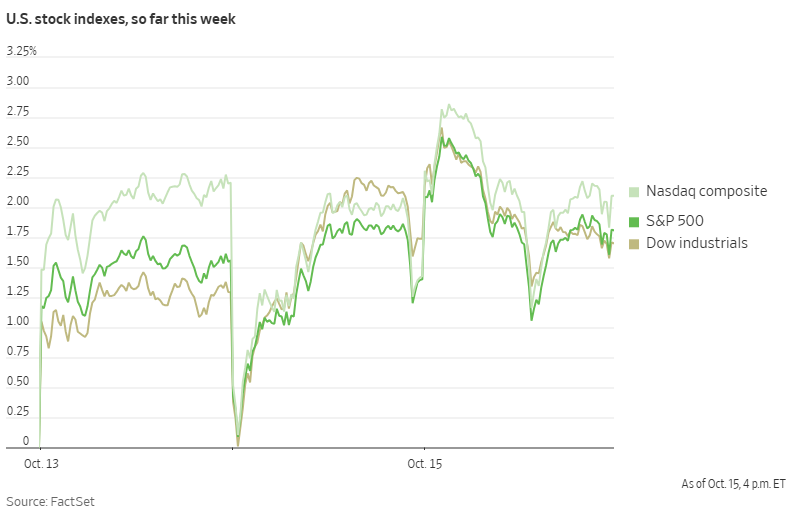
On the Australian front, the benchmark ASX 200 leapt 1.03% to 8990.99, with all four major Australian banks playing a major role. CBA closed 1.45% higher, Westpac 1.98%, NAB 1.87%, and ANZ 0.53%.
These strong bank results indicate broader economic strength, despite recent concerns about US-China trade tensions. US Treasury Secretary Scott Bessent emphasised that Washington did not want to escalate trade conflict with China and noted that President Trump is ready to meet Chinese President Xi Jinping in South Korea later this month.
With the third-quarter earnings season just getting underway, these early positive results from financial institutions could prove as the start of continued market strength through to the end of the year.
U.S. Government Shutdown Likely to Last Into November
Washington remains gridlocked as the U.S. enters its 16th day of shutdown. With no signs of compromise on the horizon, it appears increasingly likely the shutdown will extend into November and could even compromise the Thanksgiving holiday season.
Treasury Secretary Scott Bessent has warned "we are starting to cut into muscle here" and estimated "the shutdown may start costing the US economy up to $15 billion a day."
The core issue driving the shutdown is healthcare policy, specifically the expiring Affordable Care Act subsidies. Democrats are demanding these subsidies be extended, while Republicans argue this issue can be addressed separately from government funding.
The Trump administration has taken steps to blunt some of the shutdown's immediate impact, including reallocating funds to pay active-duty soldiers this week and infusing $300 million into food aid programs.
However, House Speaker Mike Johnson has emphasised these are merely "temporary fixes" that likely cannot be repeated at the end of October when the next round of military paychecks is scheduled.
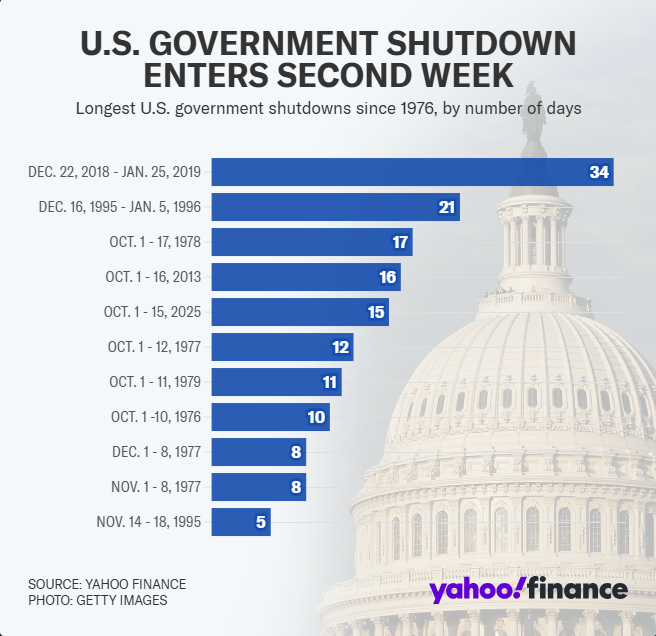
By the end of this week, this shutdown will become the third-longest in U.S. history. If it continues into November 4th, it will surpass the 34-day shutdown of 2018-2019 to become the longest government shutdown ever recorded.
This prolonged shutdown adds another layer of volatility to markets. While previous shutdowns have typically had limited long-term market impacts, the unprecedented length and timing of this closure, combined with its expanding economic toll, warrant closer attention as we move toward November.
Trump Announces Modi Has Agreed to Stop Buying Russian Oil
Yesterday, Trump announced that Indian Prime Minister Narendra Modi has agreed to stop purchasing Russian oil. He stated that Modi assured him India would halt Russian oil imports "within a short period of time," describing it as "a big step" in efforts to isolate Moscow economically.
The announcement comes after months of trade tensions between the US and India. In August, Trump imposed 50% tariffs on Indian exports to the US, doubling previous rates and specifically citing India's Russian oil purchases as a driving factor.

India has been one of Russia's top oil customers alongside China in recent years. Both countries have taken advantage of discounted Russian oil prices since the start of the Ukraine invasion.
Analysis suggests India saved between $2.5 billion to $12.6 billion since 2022 by purchasing discounted Russian crude compared to other sources, helping support its growing economy of 1.4 billion people.
Trump suggested that India's move would help accelerate the end of the Ukraine war, stating: "If India doesn't buy oil, it makes it much easier." He also mentioned his intention to convince China to follow suit: "Now I've got to get China to do the same thing."
The Indian embassy in Washington has not yet confirmed Modi's commitment. Markets will be closely watching for official statements from India and monitoring oil trading patterns in the coming weeks to assess the potential impact on global energy flows and prices.
Chart of the Day - Gold futures CFD (XAUUSD)


Most traders understand EA portfolio balance through the lens of traditional risk management — controlling position sizes, diversifying currency pairs, or limiting exposure per trade.
But in automated trading, balance is about deliberately constructing a portfolio where different strategies complement each other, measuring their collective performance, and actively managing the mix based on those measurements.
The goal is to create a “book” of EAs that can help diversify performance over time, even when individual strategies hit rough patches.
A diversified mix of EAs across timeframes and assets can, in some cases, reduce reliance on any single strategy. This approach reduces dependency on any single EA’s performance, smooths your overall equity curve, and builds resilience across changing market conditions.
It’s about running the right mix, identifying gaps in your coverage, and viewing your automated trading operation as an integrated whole rather than a collection of independent systems.
Basic Evaluation Metrics – Your Start Point
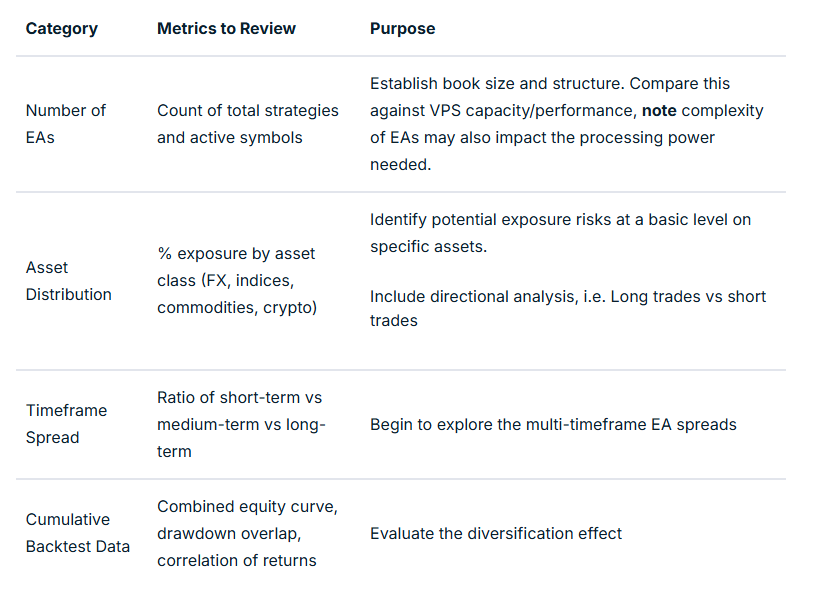
Temporal (timeframe) Balancing
When combined, a timeframe balance (even on the same model and instrument) can help flatten equity swings.
For example, a losing phase in a fast-acting M15 EA can often coincide with a profitable run in an H4 trend model.
Combining this with some market regime and sessional analysis can be beneficial.
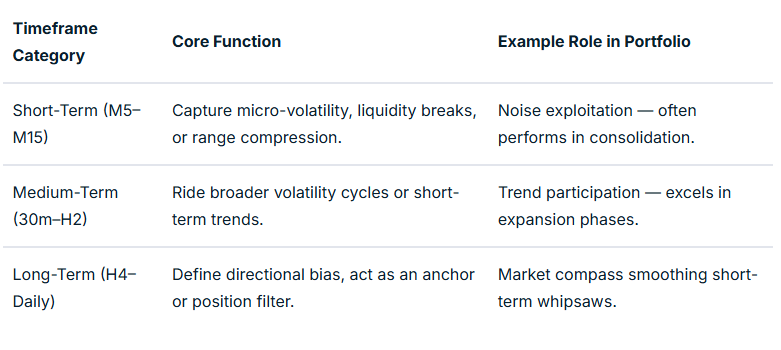
Asset Balance: Managing Systemic Correlation Risk
Running five different EAs on USDJPY might feel diversified if each uses different entry logic, even though they share the same systemic market driver.
But in an EA context, correlation measurement is not necessarily between prices, but between EA returns (equity changes) relating to specific strategies in specific market conditions.
Two EAs on the same symbol might use completely different logic and thus have near-zero correlation.
Conversely, two EAs on a different symbol may feel as though they should offer some balance, but if highly correlated in specific market conditions may not achieve your balancing aim.
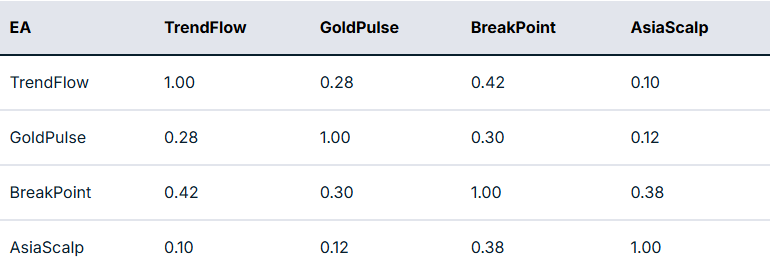
In practical terms, the next step is to take this measurement and map it to potential actionable interventions.
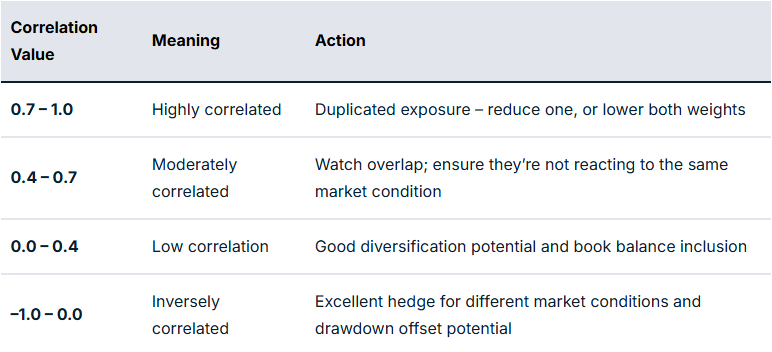
For example, if you have a EURUSD Trend EA and a GBPUSD Breakout EA with a correlation of 0.85, they are behaving like twins in performance related to specific market circumstances. And so you may want to limit exposure to some degree if you are finding that there are many relationships like this.
However, if your gold mean reversion EA correlates 0.25 compared to the rest of your book, this may offer some balance through reducing portfolio drawdown overlap.
Directional and Sentiment Balance
Markets are commonly described as risk-on or risk-off. This bias at any particular time is very likely to impact EA performance, dependent on how well balanced you are to deal with each scenario.
You may have heard the old market cliché of “up the staircase and down the elevator shaft” to describe how prices may move in alternative directions. It does appear that optimisation for each direction, rather than EAs that trade long and short, may offer better outcomes as two separate EAs rather than one catch-all.
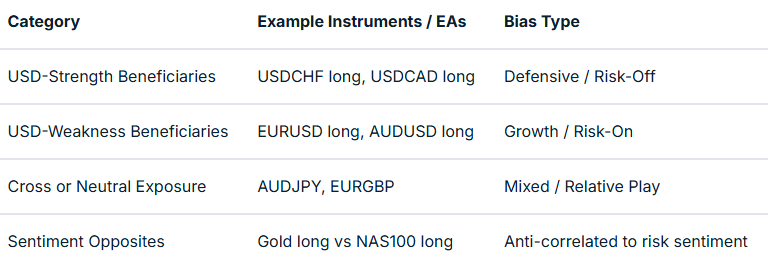
Market Regime and Volatility Balance
Trend and volatility states can have a profound impact on price action, whether as part of a discretionary or EA trading system. Much of this has a direct relationship to time of day, including the nature of individual sessions.
We have a market regime filter that incorporates trend and volatility factors in many EAs to account for this. This can be mapped and tested on a backtest and in a live environment to give evidence of strategy suitability for specific market conditions.
For example, mean reversion strategies may work well in the Asian session but less so in strongly trending markets and the higher volatility of the early part of the US session.
As part of balancing, you are asking questions as to whether you actually have EA strategies suited to different market regimes in place, or are you using these together to optimise book performance?
The table below summarises such an approach of regime vs market mapping:
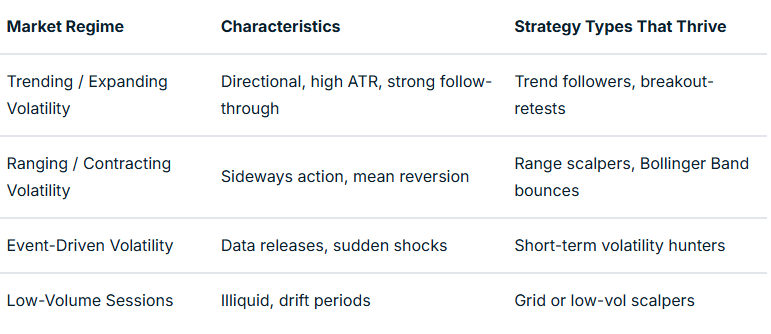
Multi-Level Analysis: From Composition to Interaction
Once your book is structured, the challenge is to turn it into something workable. An additional layer of refinement that turns theory and measurement into something meaningful in action is where any difference will be made.
This “closing the circle” is based on evidence and a true understanding of how your EAs are behaving together. It is the step that takes you to the point where automation can begin to move to the next level.
Mapping relationships with robust and detailed performance evaluation will take time to provide evidence that these are actually making a difference in meeting balancing aims.
To really excel, you should have systems in place that allow ongoing evaluation of the approaches you are using and advise of refinements that may improve things over time.
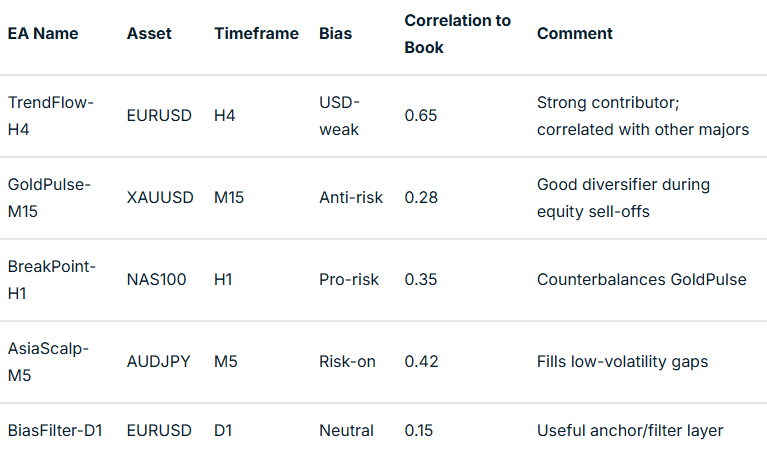
What Next? – Implementing Balance in Practice
Theory must ultimately translate into an executable EA book. A plan of action with landmarks to show progress and maintain motivation is crucial in this approach.
Defining classification tags, setting risk weights, and building monitoring dashboards are all worth consideration.
Advanced EA traders could also consider a supervisory ‘Sentinel’ EA, or ‘mothership’ approach, to enable or disable EAs dynamically based on underlying market metrics and external information integrated into EA coding decision-making.
Final Thoughts
A balanced EA portfolio is not generated by accident; it is well-thought-out, evidence-based and a continuously developing architecture. It is designed to offer improved risk management across your EA portfolio and improved trading outcomes.
Your process begins with mapping your existing strategies by number, asset, and timeframe, then expands into analysing correlations, directional bias, and volatility regimes.
When you reach the stage where one EA’s drawdown is another’s opportunity, you are no longer simply trading models but managing a system of EA systems. To finish, ask yourself the question, “Could this approach contribute to improved outcomes over time?”. If your answer is “yes,” then your mission is clear.
If you are interested in learning more about adding EAs to your trading toolbox, join the new GO EA Programme (coming soon) by contacting [email protected].


The rise of algorithmic trading has made it possible for traders of all levels to execute trades with precision and discipline 24/7.
However, while algorithms, such as Expert Advisors (EAs) used on MT4or MT5, remove emotion from the execution, they cannot remove the human element from trading.
The psychological challenges may be different when using EAs than those facing the discretionary trader, but challenges still exist.
Every automated strategy reflects the trading beliefs, thinking, logic, and discipline of its creator. This is true in development and in a live environment.
The “code” in EA trading should mean more than lines of MQL5. It should be based on a code of conduct that defines the standards by which you operate.
In a world where automation can amplify both success and mistakes, a structured set of principles helps ensure EAs remain a tool for improvement, not a shortcut to risk.
1. Use EAs as Trading Tools, Not Replacements for Good Practice
EAs are instruments, tools of the trade, not a replacement for skill, judgment, or responsibility. Their role is to supplement a trader’s edge, not substitute for it.
For example, a swing trader who relies on price-action patterns might automate only specific entry conditions to ensure consistency, while continuing to manage exits manually.
Conversely, a systematic trader may automate the entire process but still monitor performance against broader market regimes as a filter for entering or exiting automated trades.
Before an EA is ever switched on, traders must ask: What problem is this solving for me? Is it improving my execution discipline, making sure I miss fewer trading opportunities, or helping me diversify and trade efficiently across multiple markets?
Automation magnifies intent and thoroughness in peroration, execution and system refinement. If your answer is simply “to make money while I sleep,” the foundation is not enough, and perhaps you should look a little deeper.
2. Design with Clarity and Thoroughness
The design phase is where your EA professionalism begins. Every EA must be built on a clear, rules-based logic that matches the trader’s intent and desire to take advantage of specific price action.
In practice, this means you need to define exactly what the EA is supposed to do from the outset and, equally, what it will not do.
Integrity in design means documenting your logic before you code it. Write out the concept in plain language.
“Enter long when a bullish engulfing candle forms above the 20 EMA during the London session.”
“Exit when RSI crosses below 70 or after two ATRs in profit.”
Once defined, those conditions become the contract between the trader and the code.
Whether you are attempting to code yourself, using a third party to code for you or even using an off-the-shelf EA, ambiguity or lack of clarity should be addressed.
Without this, there will always be a temptation to shift or a failure to recognise the need for refinement.
3. Test with Transparency
Backtesting is often where enthusiasm overtakes discipline. It’s easy to be seduced by an impressive equity curve, yet testing is only valuable when it’s transparent.
Successful EA traders will often treat every backtest as additional data, not exclusive hard validation that an EA definitely perform in a live market environment.
They record settings, market conditions, and measure key metrics, saving results journal and different versions. This allows an objective comparison and sets the foundations for what should be measured on an ongoing basis.
Transparency also means using realistic conditions — spreads, slippage, and ticks rather than OHLC for final testing, all provide a greater quality of metrics that may more accurately mirror live trading.
A good practice is to maintain a “testing log” alongside the EA code. For example:
- Version number
- The purpose of the test (e.g., confirm logic or optimise ATR period for setting stop or take profit levels)
- The conditions under which it was run, including underlying market conditions and arguably directional and sessional differences.
- The interpretation of results (what was learned, not just the numbers)
4. Avoid the Illusion of Certainty
The temptation to fine-tune parameters until a backtest looks flawless is a trap known as overfitting.
It produces systems that may often perform brilliantly on historical data but collapse in a heap in live markets, where other external variables can be equally, if not more influential.
The necessity for and rigour and robustness in testing include approaches such as:
- Forward testing: Running the EA on new data to confirm behaviour.
- Walk-forward analysis: Re-optimising in rolling segments to ascertain whether there is parameter stability.
- Parameter clustering: Checking if profitability holds across a range of values rather than one precise setting. E.g., it will still be profitable if a level of partial close is 40, 50 or 60% of your position.
A robust EA trader accepts uncertainty as reality. A recognition that markets can evolve, conditions often shift, and no single setting is likely to remain optimal forever.
Your goal is durability, not perfection in a single set of market conditions.
An EA that performs moderately well across different conditions is often far more valuable than one that looks brilliant in backtest isolation.
5. Adequate Preparation for Live Execution
The transition from backtest to live trading is not something to take lightly; it is a major operational step. Before going live, traders should have a checklist covering readiness that includes confirmation of logic, appropriate infrastructure, and management of risk.
Steps to achieve this aim can include:
- Running the EA in visual backtest mode to confirm correct trade placement.
- Checking symbol specifications, such as contract size, margin requirement, and swap cost.
- Confirming VPS stability — low latency, sufficient processing power for the number of EAs you are trading, and reliability
- Testing on a demo account first, under live market conditions and then move to a live environment using minimum trading volume before scaling.
EA traders should have a set of minimum values for key metrics such as Net profit vs balance drawdown, win rate, consecutive wins and losses and Sharpe ratios before moving to live.
A full checklist that incorporates minimum testing performance as well as infrastructure management is critical.
6. Manage Risk is About You, Not Your EA
The most dangerous misconception in automated trading is that the EA “handles risk.” It does not. It simply executes your instructions, whether these are good or bad for a particular trade.
As a trader, you remain responsible for every lot size, margin call, and equity swing. Proper capital management means understanding total exposure across all running EAs as a whole, not just an individual one.
Running five EAs, of which risks 1% of account equity per trade is not necessarily diversification, particularly if the assets are heavily correlated.
In the same way that you should be rigorous in decision-making from test to live environment, it is equally important when scaling, i.e., increasing trading lot sizes.
Scaling rules should be data-based and only considered after a defined critical mass of trading activity of a single EA. Only increasing trade size when the EA’s equity curve maintains a positive slope over a rolling period, or when the profit factor exceeds a set threshold for a given number of trades.
Once scaling is taking place beyond the minimum volume, it may be worth considering the implications of the reality that risk is dynamic.
Experimenting with adjusting lot size against the strength of the signal or underlying market conditions for specific EAs may be worthwhile.
7. Monitor, Measure, and Refine
A live EA is not a “set-and-forget” machine. It’s a continuous process that requires observation and refinement on an ongoing basis
Regular and planned reviews of EA performance through appropriate reporting will always reveal valuable insights beyond your overall account balance. Aim to answer questions such as:
- Is the EA behaving as designed?
- Are trade times and volumes consistent with expectations?
- Has the average profit per trade decreased, suggesting a changing market structure?
A disciplined EA trader will use these insights to decide when to pause, adjust, or retire an EA. For instance, if a breakout EA consistently loses during low-volatility sessions, the solution might not be “optimise again” but to restrict trading hours within the parameters.
8. Maintain Operational Discipline
Even the best logic fails if your trading environment is unstable or unsuitable. Operational discipline ensures that the infrastructure supporting EAs is reliable, secure, and constantly monitored for any “events” that may influence the execution of your book of EAs.
This includes maintaining a properly configured VPS (Virtual Private Server) with sufficient CPU capacity and regular monitoring of resource use.
Traders should track activity, confirming that log files are saving correctly, and not only know how to install their EA to trade live (and other files that may be necessary for it to run, e.g., include files) but also how to restart or stop an EA without disrupting open trades.
Operational discipline also extends to record-keeping and organisation of your automated trading performance evaluations and resources. Notes on anything that looks unusual for further review, and systems that dictate when you take actions, are all part of putting the right things in place.
Final Thoughts
Your Code of Conduct for EA Traders is not a rulebook but a roadmap for moving towards excellence in the design, deployment, and management of automated trading systems.
Although each standard can stand alone as something specific to work on, they are also inextricably linked to the whole.
View your automated trading as an extension of who you are and want to become as a trader. An EA can execute your edge, but it cannot replace your accountability for actions, your need for learning and improvement, nor your commitment towards better trading outcomes.
The best traders don’t just build and use algorithms; they build standards of practice and follow through to move towards becoming a successful EA trader.

